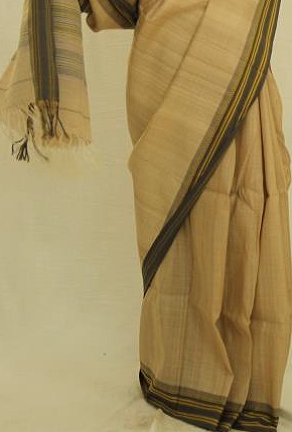Karvati Silk Saree
Karvati Silk Saree
Background
In earlier days, handloom weavers of village Andhalgaon, Mohadi and Palandur District Bhandara, the part of Vidarbha region in Maharashtra used to produce cotton gamchha with 20s cotton yarn in warp and weft having two side Karvati border (Solid border). “Karvat” in Marathi is the saw and since the designs look like saw tooth, the fabric is known as Karvati or Karvatkati. District Bhandara is a tasar cocoon producing area. Having plenty raw material the weavers introduced tasar material in weaving of Tasar Karvati Saree.

Material Used
The tasar is wild natural silk obtained from a wide wing moth that is yellowish brown in colour. The tasar produced in the Vidarbha region of Maharashtra State is supposed to be best in quality and colour due to unique environmental conditions of this region. Mostly the tribals are traditionally doing the job of protecting cocoons on trees in forests. The tasar yarn so obtained is used for production of sarees.
Technique applied
The Tasar Karvati Saree is woven with three shuttle weaving (tapestry type of weaving technique) to have solid colour border and body. The border is woven with mercerized cotton yarn and body is woven with pure tasar hand reeled yarn. The saree is woven on pit loom mounted with Nagpuri wooden lattice dobby on the top of the loom above the weaver’s seat. The uniqueness of the Tasar Karvati Saree is that, the border of the saree is woven with various temple designs in different sizes. The traditional motifs are woven with extra warp threads controlled by lattice dobby.
How to distinguish
- Hand reeled tasar is used. Fabric appearance is not flat and uniform. There are uneven picks in irregular fashion.
- Feel is harsh and the colour is darker beige
- Saw tooth designs of various sizes are woven in the border of the saree in tapestry technique.
Source : India Handloom Brand
Last Modified : 9/5/2023
